Authors
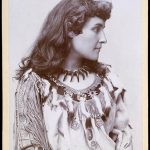
| E. Pauline Johnson (Tekahionwake) | |
| Title |
|---|
Written by CanLit Guides' Editorial Team
E. Pauline Johnson (Tekahionwake; 1861–1913) was a popular poet, critic, and performer. In this chapter, we address a small sampling of her wide range of poems and prose. The life and career of Pauline Johnson has been the subject of renewed academic attention since the 1960s, in particular with the growing interest in feminism, Indigeneity, and diversity.

| Visual Poetry and Indigenous-Settler Issues: Shane Rhodes and Jordan Abel | |
| Title |
|---|
Written by CanLit Guides' Editorial Team
This chapter includes several contemporary visual poems by non-Indigenous poet Shane Rhodes (b. 1973) and Nisga’a poet Jordan Abel (b. 1985). These poems engage with the ways that land negotiations, treaties, and cultural documentation dispossessed Indigenous peoples.
Drama

| Goodnight Desdemona (Good Morning Juliet) by Ann-Marie MacDonald | |
| Title |
|---|
Written by CanLit Guides' Editorial Team
Ann-Marie MacDonald’s widely produced play, and winner of the 1990 Governor General’s Award for Drama, presents Constance Ledbelly, an academic who is sucked into and disrupts the story-worlds of two Shakespearean plays, Othello and Romeo and Juliet.

| The Rez Sisters by Tomson Highway | |
| Title |
|---|
Written by CanLit Guides' Editorial Team
The Rez Sisters launched Highway’s career as a notable and influential playwright in Canada, and earned him a Dora Mavor Moore Award in 1987. The play was initially performed only in Indigenous communities, but then moved to major stages across the country.
Fiction
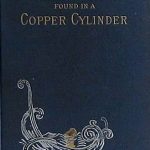
| A Strange Manuscript Found in a Copper Cylinder by James De Mille | |
| Title |
|---|
Written by CanLit Guides' Editorial Team
Published posthumously in 1888, James De Mille’s A Strange Manuscript Found in a Copper Cylinder tells a satiric story of a lost utopia through a frame narrative and an internal tale ostensibly found in a bottle floating at sea. The questions in this case study guide students through the frame narrative structure, as well as the use of irony and problematic depictions of utopia.
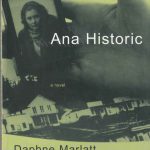
| Ana Historic by Daphne Marlatt | |
| Title |
|---|
Written by CanLit Guides' Editorial Team
Influenced by both avant-garde poetry and Virginia Woolf’s stream of consciousness narrative mode, Daphne Marlatt’s Ana Historic follows the mind of the narrator, Annie, at work. While researching the history of Mrs. Richards, a mysterious woman who appears in the civic archives of Vancouver in 1873, Annie’s mind jumps from her research to her personal struggle with her mother’s suicide, intermingling the three women’s stories on the page. The layout and typography change as perspective shifts, offering a collage of the women’s lives, serving as analogues to one another.
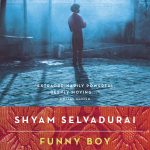
| Funny Boy by Shyam Selvadurai | |
| Title |
|---|
Written by CanLit Guides' Editorial Team
Shyam Selvadurai’s novel Funny Boy presents the coming of age of Arjie, a young, gay, Tamil boy in Sri Lanka. Set against the backdrop of Sri Lankan social and cultural politics of the 1980s, the novel explores the barriers around love, marriage, gender expectations, and cultural tensions, specifically in the Sinhala and Tamil populations. The tension and change in Sri Lanka during the 1980s leading up to the events of Black July parallel the development of Arjie’s own tumultuous realization of his homosexual identity.
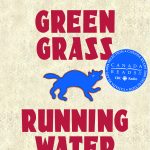
| Green Grass, Running Water by Thomas King | |
| Title |
|---|
Written by CanLit Guides' Editorial Team
Thomas King’s storytelling, publications, and talks play a significant role in developing Indigenous literatures in Canada and the United States. Green Grass, Running Water, a finalist for the 1993 Governor General’s Award, remains one of his most popular works.
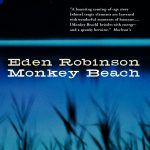
| Monkey Beach by Eden Robinson | |
| Title |
|---|
Written by CanLit Guides' Editorial Team
Haisla/Heiltsuk writer Eden Robinson’s first book, a collection of stories called Traplines, was published to critical acclaim in 1996. Robinson then adapted one story from the collection, Queen of the North, into her debut novel, Monkey Beach, which was shortlisted for the 2000 Governor General’s Award and the Giller Prize, and won the Ethel Wilson Fiction Prize.
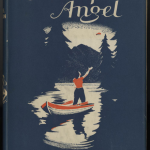
| Swamp Angel by Ethel Wilson | |
| Title |
|---|
Written by CanLit Guides' Editorial Team
Considered one of Wilson’s most accomplished works, Swamp Angelfollows Maggie Vardoe (later Lloyd) as she flees her husband in Vancouver to help run a fishing lodge in the interior of British Columbia. The novel illustrates the tension between her personal autonomy as a woman, and the needs and perceptions of a largely heteronormative community. Through the transformations of the main character, we can observe a process of attaining personal agency and self-actualization in the midst of societal constraints.
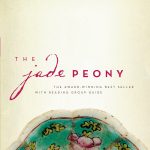
| The Jade Peony by Wayson Choy | |
| Title |
|---|
Written by CanLit Guides' Editorial Team
Wayson Choy’s novel follows a Chinese Canadian family in Vancouver around the time of World War II, through the eyes of the three youngest children. The story draws on the history of Chinese labourers on the railway, the perpetual navigations of and tensions caused by cultural difference, perceptions of Japanese Canadians, and other national and cultural identifications dominant at the time.

| The Wars by Timothy Findley | |
| Title |
|---|
Written by CanLit Guides' Editorial Team
The Wars, which won the Governor General’s Award for Fiction in 1977, is an example of what influential Canadian literature critic and theorist Linda Hutcheon terms historiographic metafiction.

| What We All Long For by Dionne Brand | |
| Title |
|---|
Written by CanLit Guides' Editorial Team
Dionne Brand’s 2005 novel What We All Long For explores the experiences of a small group of friends in Toronto and their troubled family histories, in particular touching on how processes and forces of global travel, nationalism, culture, racialization, and economic disparities inform their identities. This set of stories interweave with the story of one lost family member, Quy, who struggles to rejoin his family through an international maze of barriers.

| An Introduction to the Short Story in Canada: Reading Alice Munro’s Who Do You Think You Are? | |
| Title |
|---|
Written by Nadine Fladd
This chapter introduces the short story as a literary genre, and discusses the short story cycle as a particularly important genre in Canada. It offers some suggestions for analyzing short stories from print culture and feminist perspectives, and it turns to Alice Munro’s 1978 short story cycle Who Do You Think You Are? as a case study in putting these perspectives to work.
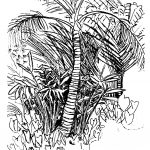
| Close Reading Prose | |
| Title |
|---|
Written by CanLit Guides' Editorial Team
The goal of a close reading is to produce a convincing and thorough interpretation of a text. Even straightforward prose can contain a trove of literary devices and strategies to either guide the reader toward meaning or obfuscate meaning altogether. While close reading, it is not only important to understand what authors are saying, but also, how they are saying it.

| Douglas Coupland’s Generation A: Storytelling in a Digital Age | |
| Title |
|---|
Written by Shannon Smyrl
Douglas Coupland’s 2009 novel Generation A exposes and probes core cultural anxieties related to isolation, mass commercialism, and environmental destruction—threats that feel imminent in our current digital world. As you study Generation A, look beyond this surface to consider how the thriller narrative is linked to the novel's larger concern with storytelling. Because, ultimately, the novel is a story about storytelling, structured as five interconnected narratives, each with embedded “campfire” stories the characters tell each other. In the end, the characters’ sharing of stories is integral to the novel’s outcome.

| Joy Kogawa’s Obasan | |
| Title |
|---|
Written by Farah Moosa
Joy Kogawa’s novel Obasan (1981) is a powerful narrative about a woman’s attempt to understand her familial past and the historical and cultural legacies she has inherited as a Japanese Canadian. Decades after its first publication, Obasan still captures the attention of many readers and is widely taught in schools, colleges, and universities in Canada. The novel has also received a great deal of critical attention—there are a number of book chapters and articles on Obasan. This chapter serves as an introduction to the novel and some of the scholarly conversations that surround it. In particular, it explores the important and interrelated themes of silence and speech, and memory and history; and it suggests some strategies for close-reading the novel.
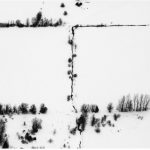
| The Future(s) of Indigenous Horror: Moon of the Crusted Snow | |
| Title |
|---|
Written by Gage Karahkwí:io Diabo
In this chapter, we will explore approaches to the topic of Indigenous horror as it applies to Anishinaabe writer Waubgeshig Rice’s apocalyptic horror novel Moon of the Crusted Snow. This introduction provides context for the novel by discussing its place within recent trends in genre studies and Indigenous literary studies. In the following sections, we will consider a handful of critical approaches to help guide our reading of the novel before turning to an analysis of key sections from the text itself.
History & Culture
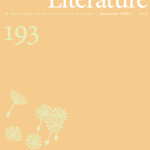
| Canada Reads | |
| Title |
|---|
Written by CanLit Guides' Editorial Team
Canada Reads is a CBC Radio program that was launched in English in 2002 and in 2004 in French as Le Combat des livres. Over the course of a week in five one-hour segments, five celebrity judges champion a book and engage in debate about which one Canadians should read. Each day a book is voted off the list until only one is left standing. The format of the program is often compared to reality TV shows such as Survivor. The show playfully foregrounds conflict in its branding, using taglines such as “battle of the books” or “literary title fight” (CBC). That said, the champion book carries a lot of cultural cachet and the show has had enormous impact on the development of a popular Canadian reading public.

| Canadian Literature and the Canada-US Border | |
| Title |
|---|
Written by Gillian Roberts
This chapter introduces Canadian literature’s relationship to the field of Canada-US Border Studies. In what we might call Canadian “border texts,” the border features prominently, if variably. The Canadian nation is a contested space, a site of struggle over political and cultural values between groups with diverging interests. Canadian border texts reveal the border as a site of struggle, too, figuring differently from different people’s perspectives. In analyzing these literary texts, we see that at times—for some people—the border appears porous and permeable, and at other times—for other people—impenetrable.
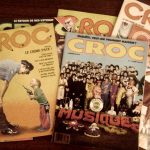
| Comics and Canadian Literature | |
| Title |
|---|
Written by Brenna Clarke Gray
Some of the most significant names in Canadian literature—people like author Margaret Atwood and poet bpNichol—have throughout their careers played with comics as part of their larger body of work. Literary scholars have often paid attention when “serious” writers engage in comics, such as Carl Peters in his collection bpNichol Comics, or Reingard M. Nischik’s attention to Atwood’s comics in her Engendering Genre. But how do we analyze comics produced in Canada by comics creators? We now see comics appearing more frequently in college and university courses, including in Canadian literature classes. Yet the history, scholarship, and language of literary study do not always neatly transpose onto the world of comics. This chapter is designed to introduce new comics readers to the history of creating and evaluating comics in Canada and to the practice of reading them as scholars.

| Diaspora Studies and Canadian Literature | |
| Title |
|---|
Written by L. Camille van der Marel
When traced to its Greek roots, the term “diaspora” means to scatter about, to disperse. Imagine dandelion seeds on the wind: this image is often used to introduce students to the concept of diaspora. Indeed, dandelion seeds are a common symbol for departments, journals (including Canadian Literature), book series, and conferences that specialize in or incorporate diaspora studies. Analyzing the image of dandelion seeds on the wind is a good way to begin thinking about the complexities and nuances that inform readings of diasporic literature.

| Feminist History of Literature and Culture in Canada | |
| Title |
|---|
Written by CanLit Guides' Editorial Team
Feminist literary scholars analyze and consider the representation of gender in literary and cultural works while considering the societal implications of these representations. However, scholars do not come up with theories of gender representation in a vacuum. The work of feminist activists in the community, media, and political arena influence the academic work of feminist scholars—and vice versa.
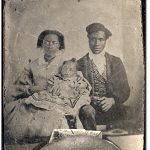
| Indigenous and Diasporic Intersections in Canadian Literature | |
| Title |
|---|
Written by L. Camille van der Marel
Indigenous and diasporic texts are often taught in the same Canadian literature classes and have shared concerns with race, displacement, identity, and community. That said, literary scholars rarely place these literatures in dialogue with one another. This chapter offers guidance for those trying to see, discuss, and research the connections between these two bodies of literature.

| Indigenous Literary History (1960s-1990) | |
| Title |
|---|
Written by CanLit Guides' Editorial Team
Several important political developments in the 1960s helped strengthen Indigenous nationalism in Canada. Until the 1960s, Status Indians—peoples legally recognized by the Indian Act—lacked many rights enjoyed by Canadian citizens, as the Indian Act categorized them as wards of the state.

| Introduction to Nationalism | |
| Title |
|---|
Written by CanLit Guides' Editorial Team
A nation is a group of people who regard themselves as sharing the same culture; a state is a group of people governed by the same laws and political institutions. Groups of people connected through history settled within a geographical region, building customs and forming dialects. Modern nations emerged from the desire of such groups to claim and defend land for hunting, gathering, agriculture, and other economic activities. The borders on contemporary maps resulted from long histories of negotiations and wars among nations and nation-states to control particular territories.

| Literary Censorship and Controversy in Canada | |
| Title |
|---|
Written by Lucia Lorenzi
This chapter introduces you to literary censorship in Canada, looking both at positions taken by Canadian scholars on the practice of censorship and its effects, as well as at specific examples. We will analyze controversies around three texts to better see how the censorship of Canadian literature works in practice: Timothy Findley’s The Wars (1977) and Beatrice Culleton Mosionier’s In Search of April Raintree (1983) provide examples of censorship where the authors themselves were involved in contesting or responding directly to critics in their texts; Raziel Reid’s When Everything Feels Like the Movies (2014) provides an example of a contemporary attempt to strip a novel of its literary award on the basis of its allegedly controversial content.

| Narratives of Empire: Hearne and Mackenzie | |
| Title |
|---|
Written by CanLit Guides' Editorial Team
The stereotype of the explorer is a single European man, often pictured standing at the bow of a ship looking off to the horizon, or planting a flag on some new territory to claim it for the empire.
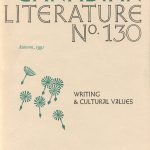
| Nationalism and Literature: Cross-Genre Connections | |
| Title |
|---|
Written by CanLit Guides' Editorial Team
In this critical writing assignment, compare and contrast one book and at least one (or even a few) of the following poems (or select from others found in this unit).

| Nationalism, 1500–1700s: Exploration and Settlement | |
| Title |
|---|
Written by CanLit Guides' Editorial Team
The development of cultures and nation states is characterized by migration (see Diamond and Wolf). With the advent of new technologies to connect people all over the world, such as airplanes and the Internet, this slow migration accelerated in the twentieth century, and continues to gather speed. This phenomena, also known as globalization, reflects the shift toward the colonial expansion of empires, starting in Canadian history with English and French colonization and continuing as well as in more contemporary forms of international immigration and trade.
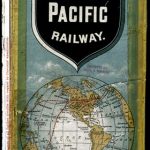
| Nationalism, 1800s: Loyalism and Nation-building | |
| Title |
|---|
Written by CanLit Guides' Editorial Team
Loyalism, still strongly colonial rather than national at this time, helped develop a problematic and still pervasive collective concept of Canada as a white, Christian, primarily Anglophone, civil society.

| Nationalism, 1950s–1970s: Cultural Nationalism, the Massey Commission, and Thematic Criticism | |
| Title |
|---|
Written by CanLit Guides' Editorial Team
A form of nationalism particularly relevant to the study of Canadian literature is cultural nationalism, which argues for the support, recognition, and preservation of cultural institutions and products as necessary elements of national identity. This nationalism has sometimes been driven by a desire for self-articulation and sometimes by cultural protectionism.

| Nationalism, 1960s onwards: Multiculturalism | |
| Title |
|---|
Written by CanLit Guides' Editorial Team
In the 1960s and 70s, the unified vision of a culturally homogeneous nation run by elite white men was fractured by civil rights movements against racial discrimination, the women’s movement, and the Quiet Revolution in Quebec. The Quiet Revolution, which became noisier over time, led to the referendums on sovereignty in 1980 and 1995 because of the division between federalist and sovereignist political factions.

| Nationalism, 1980s onwards: Contesting Multiculturalism | |
| Title |
|---|
Written by CanLit Guides' Editorial Team
Multiculturalism itself is not a settled concept—even though it is legislated in Canada—and it continues to be developed or contested in various ways.

| Nationalism, late 1800s–1950s: Canadian Immigration and War | |
| Title |
|---|
Written by CanLit Guides' Editorial Team
In the nineteenth century, Canada created assimilationist legislation for the governance of Aboriginal peoples (see especially the Indian Act of 1876), producing the residential school system among other initiatives that sought to eradicate cultural differences.

| Official Multiculturalism’s Funding of Canadian Literature: The Writing and Publications Program | |
| Title |
|---|
Written by Brendan McCormack
In this chapter, we will explore how “official multiculturalism”—that is, multiculturalism as a federal government policy in Canada—has influenced the writing and publishing of Canadian literature. While you have likely already thought about multiculturalism as part of the social context within which Canadian literature circulates, or about which Canadian authors write, official multiculturalism has also supported the production of Canadian literature itself. This chapter will introduce you to the history of the Writing and Publications Program (WPP), through which Canada’s federal multiculturalism directorate provided funding for literature from the 1970s-1990s.

| Orature and Literature | |
| Title |
|---|
Written by CanLit Guides' Editorial Team
Many early anthropologists argued that all societies transition from hunter-gatherer, to nomadic herding, to agriculture, to the formation of large cities in the same way, and that the later stages were superior to the earlier ones. Anthropology has moved on from this idea; however, the idea that certain societies are superior to others is connected with other widespread ideas such as the myth of progress (new technologies are invariably better), Whig history (past societies are evolving towards democratic freedom), Social Darwinism (the fittest humans survive best, so the poor should be left to starve), and Scientific Racism (whites or Caucasians are at the top of an evolutionary ladder).

| Shifting Representation: Ronnie the Bren Gun Girl | |
| Title |
|---|
Written by CanLit Guides' Editorial Team
Despite the hyper-masculinity of early to mid-twentieth century modernism, representations of gendered spaces and relationships began to shift with the World Wars, which produced the need for women to play a greater role in public life. Much of this shift was influenced by the need for women to work in factories, filling the positions traditionally held by the men now risking their lives at the front.

| The Periodical Press: Newspapers, Magazines, and Literary Culture in Early Canada | |
| Title |
|---|
Written by Ceilidh Hart
The book tends to get a great deal of focus in contemporary Canadian literary culture: literary awards, national reading programs such as Canada Reads, university courses, even, tend to place the book at the centre. And yet, in the nineteenth century, it was the periodical press—magazines and newspapers—that drove Canada’s cultural life. This chapter, using the writing career of Isabella Valancy Crawford as a case study, explores the importance to readers and writers alike of periodical publishing in early Canada, and the profound role it played in shaping a national literary culture at that time.
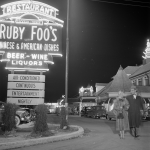
| What is “Restaurant Literature”? Depictions of Chinese Restaurants in Canadian Literature | |
| Title |
|---|
Written by Nathalie Cooke and Shelley Boyd
This chapter identifies a growing body of Canadian literary works depicting Chinese restaurants as sites and sources of narrative, and seeks to answer a series of questions. What are the characteristics of the genre of restaurant literature? What are the key texts—those responsible for shaping, reshaping, and innovating this genre? What historical contexts have influenced this genre’s development? This chapter looks closely at a representative selection of restaurant literature in order to explore ways in which authors have written Chinese restaurants into the literary landscape, and to understand storytelling’s ability to introduce readers to new characters, cultures, and perspectives over time.
Literary Theory

| An Introduction to Gender and Sexuality | |
| Title |
|---|
Written by CanLit Guides' Editorial Team
This guide draws attention to the centrality of gender and sexuality in the discussion of Canadian literature and culture, and to the kinds of criticism done within the journalCanadian Literature. Understanding how gender and sexuality are constructed is a central scholarly concern in understanding Canada’s national and literary imagination. To see this, we can begin by considering early propaganda images that constructed Canada’s West as an idealized and harmonious community awaiting settlers.

| An Introduction to Indigenous Literatures in Canada | |
| Title |
|---|
Written by CanLit Guides' Editorial Team
In Canadian Literature’s groundbreaking 1990 special issue, Native Writers & Canadian Writing, W. H. New argues in his editorial that “Power declares; it doesn’t readily listen” (4). At the time,Canadian Literature still represented the power of the Canadian literary establishment, but for this issue the journal attempted to critically listen and engage with Indigenous writers, rather than speak over them. By implication, this shift also means the journal asked its readership to become willing listeners about Indigenous literature, in all its contradictions and complications.
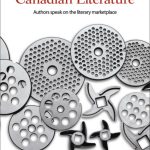
| An Introduction to Producing and Evaluating Canadian Texts | |
| Title |
|---|
Written by CanLit Guides' Editorial Team
Studies of literary prizes (Roberts), the economics of literature (English), and the hidden labour of reading for pleasure (Shukin) are expanding the fields of literary studies. These scholars are among many academics that are rethinking the study of literature in a media-driven age.
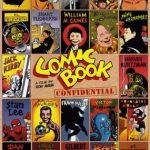
| English-Language Comics and Graphic Novels in Canada | |
| Title |
|---|
Written by CanLit Guides' Editorial Team
Comics include a range of forms and genres, including the popular graphic novel, and go by a variety of names like cartoons, comix, the funnies, graphica, graphic literature, sequential art, and visual literature. Comics has remained the most popularly accepted general term, with the recognition that comics aren’t always funny.

| Nationalism, Now: Ongoing National Conversations | |
| Title |
|---|
Written by CanLit Guides' Editorial Team
Contemporary debates about Canadian nationalism in Canadian literature reflect ongoing concerns with power, history, cultural diversity and with their effects on individuals, communities, and the nation state.
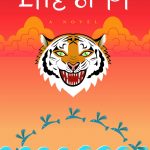
| Paratexts and Literary Value | |
| Title |
|---|
Written by CanLit Guides' Editorial Team
The Author’s Note is part of the paratext of Yann Martel’s Life of Pi that helps the text establish its cultural value. The Author’s Note is written in first person, and the title of the piece—“Author’s Note”—implies the speaker is Yann Martel, the author whose name is on the cover of the physical book. The speaker even gives a history of how he came to write “[t]his book” (v) by explaining his previous literary failures, some of which evoke Martel’s own earlier underwhelming literary efforts. Yet as the preface unfolds, the speaker says he met with “Mr. Patel,” the “main character” (x) of the novel Life of Pi. Suddenly, the truth of the Author’s Note is thrown into question—is the preface fact or fiction?
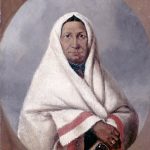
| Poetry and Racialization | |
| Title |
|---|
Written by CanLit Guides' Editorial Team
This chapter stages an imaginary conversation between Duncan Campbell Scott (born 1862), the Canadian Deputy Superintendent of Indian Affairs from 1913 to 1932, and E. Pauline Johnson (Tekahionwake; born 1861), the daughter of a Mohawk Chief and an Englishwoman. Scott and Johnson were distinctively different poets who addressed Indigenous issues from very different racialized and gendered perspectives.

| Post-nationalism? Regional, National, and Global Connections | |
| Title |
|---|
Written by CanLit Guides' Editorial Team
Discussing nationalism in terms of globalization troubles and broadens simplistic notions of place. A global perspective focuses on groups with shared interests that form affinity networks beyond national borders, such as global Indigenous movements and international associations that address educational and economic inequalities, human rights violations, and so forth.

| Postfeminism and Conservative Feminism | |
| Title |
|---|
Written by CanLit Guides' Editorial Team
Postfeminism and conservative feminism share an intellectual foundation but are different movements. Postfeminism is a critique of second- and third-wave feminism, while conservative feminism rejects the liberalism of second- and third-wave feminism. Conservative feminists argue that the age of high feminist activism ended in the 1970s, and that the feminist movement obtained its primary goals.
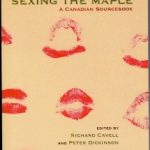
| Queer Theory and Canada | |
| Title |
|---|
Written by CanLit Guides' Editorial Team
On its face, queerness may not seem to have much to do with Canada, or Canadian literature. In an editorial for a special issue of Canadian Literature, gender studies scholar Janice Stewart discusses the Queerly Canadian conference that was held at the University of British Columbia in June of 2009. She notes that the conference “foregrounded an interdisciplinary body of scholarship that critically rethinks modernist discourses located at the nexus of Canadian nationalism and critical considerations of sexualities and genders in their multiple configurations.”

| What is Canadian Literature? | |
| Title |
|---|
Written by CanLit Guides' Editorial Team
It may seem strange to open a guide to Canadian literature by describing it as a shifting wilderness and a bewildering whirlwind. However, M. G. Vassanji’s comment serves as a warning to stay away from rigid, categorical thinking. There is no central idea, no easy essence, that binds Canadian literatures together.
Non-Fiction

| A Woman Tenderfoot by Grace Gallatin Seton-Thompson | |
| Title |
|---|
Written by Tiffany Johnstone
In 1900, young American suffragist Grace Gallatin Seton-Thompson published her first book, an account of her extended 1897 camping trip in western regions of the United States and Canada. This chapter contextualizes A Woman Tenderfoot within Canadian literature and within the genre of travel writing that was so popular at the time. It then suggests several theoretical approaches for reading A Woman Tenderfoot more closely.

| Roughing It in the Bush by Susanna Moodie | |
| Title |
|---|
Written by CanLit Guides' Editorial Team
This popular account of emigration from England and settlement in Upper Canada has become a classic in the history of Canadian literature. First published in 1852, Roughing It in the Bush describes Susanna Moodie’s impressions of the people, places, and processes of settlement in the first seven years after she arrived in Upper Canada in 1832.
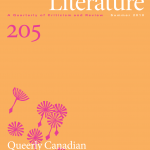
| Close Reading Journal Articles | |
| Title |
|---|
Written by CanLit Guides' Editorial Team
Academic articles are scholarly conversations. They often reference and speak to each other and allow scholars to acknowledge, criticize, engage, learn from, disagree with, and add to each other’s ideas. This conversation happens between peers with a shared language, knowledge base, and training.
Poetry
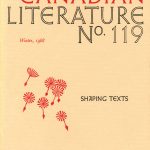
| Close Reading Poetry | |
| Title |
|---|
Written by CanLit Guides' Editorial Team
Think of close reading as similar to a criminal investigation in which we, as readers, move slowly through the language and forms of the text, working through suggested connotations, subtle connections, and implications of terms and images. Our goal is to unravel the subtle riches of expression, to solve (or glimpse) the mystery.

| Defamiliarization and Reconceptualization | |
| Title |
|---|
Written by CanLit Guides' Editorial Team
The following poems, previously published in Canadian Literature, use a variety of strategies to defamiliarize and reconceptualize their subject. These strategies include novel combinations of images, linguistic disruptions, and more.

| Dionne Brand: No Language is Neutral | |
| Title |
|---|
Written by Carl Watts
Dionne Brand’s No Language Is Neutral (1990) is a set of poems that can be understood as a meditation on migration. The book addresses the theme of movement from one location to another as it describes a journey from the Caribbean to Canada. In doing so, it outlines (and asks questions about) a conception of identity that is influenced by movement, dislocation, and variability. The following sections of this chapter summarize some scholarly debates that have taken place around No Language Is Neutral and outline some strategies for interpreting how Brand treats the experience of migration and related topics.
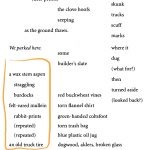
| Poetic Visuality and Experimentation | |
| Title |
|---|
Written by CanLit Guides' Editorial Team
Literature loves to throw curveballs. Contemporary writers in particular often challenge expectations and assumptions about literature by purposefully disrupting them. Wynne Francis, writing on the 1960s literary scene, observes that Canadian literature became polarized between a mass market/mainstream culture (figured as the centre, or as culture itself) and the radical fringe that expressed a counter-culture of extreme experimentalism.

| Poetry and Racialization | |
| Title |
|---|
Written by CanLit Guides' Editorial Team
This chapter stages an imaginary conversation between Duncan Campbell Scott (born 1862), the Canadian Deputy Superintendent of Indian Affairs from 1913 to 1932, and E. Pauline Johnson (Tekahionwake; born 1861), the daughter of a Mohawk Chief and an Englishwoman. Scott and Johnson were distinctively different poets who addressed Indigenous issues from very different racialized and gendered perspectives.
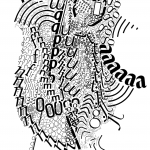
| Reading Visual Poetry | |
| Title |
|---|
Written by CanLit Guides' Editorial Team
Some poets push further, beyond visual placement of words, to visual disruption of language itself. For example non-semantic or asemic visual poetry plays with letters in a variety of ways without forming words.

| Visual Poetry and Indigenous-Settler Issues: Shane Rhodes and Jordan Abel | |
| Title |
|---|
Written by CanLit Guides' Editorial Team
This chapter includes several contemporary visual poems by non-Indigenous poet Shane Rhodes (b. 1973) and Nisga’a poet Jordan Abel (b. 1985). These poems engage with the ways that land negotiations, treaties, and cultural documentation dispossessed Indigenous peoples.
Research Skills

| Close Reading Journal Articles | |
| Title |
|---|
Written by CanLit Guides' Editorial Team
Academic articles are scholarly conversations. They often reference and speak to each other and allow scholars to acknowledge, criticize, engage, learn from, disagree with, and add to each other’s ideas. This conversation happens between peers with a shared language, knowledge base, and training.

| Close Reading Poetry | |
| Title |
|---|
Written by CanLit Guides' Editorial Team
Think of close reading as similar to a criminal investigation in which we, as readers, move slowly through the language and forms of the text, working through suggested connotations, subtle connections, and implications of terms and images. Our goal is to unravel the subtle riches of expression, to solve (or glimpse) the mystery.

| Close Reading Prose | |
| Title |
|---|
Written by CanLit Guides' Editorial Team
The goal of a close reading is to produce a convincing and thorough interpretation of a text. Even straightforward prose can contain a trove of literary devices and strategies to either guide the reader toward meaning or obfuscate meaning altogether. While close reading, it is not only important to understand what authors are saying, but also, how they are saying it.
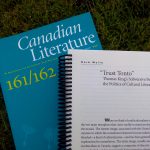
| Discovering Implicit Motivations in Canadian Literature Scholarship | |
| Title |
|---|
Written by Sarah Banting
When your instructors guide class discussion toward particular topics, or set assignment questions that encourage you to think about particular issues, they are implicitly teaching you what is of current interest in this field. As they guide your reading and thinking, they are inviting you to join the scholarly community in its ongoing conversation about pressing topics in Canadian literature studies. This chapter similarly invites you to further understand and participate in this scholarly community by highlighting some of the most frequently recurring and characteristic motivations that inspire professional scholars to make their arguments in this field. It explores how these motivations shape the development of articles in the field. And it will invite you to consider adopting these motivations in your own essays, or to see how you may have already started adopting them—perhaps even without realizing it.








 ©
©